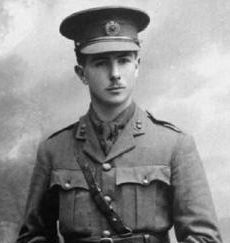
Figure 1. Lieutenant John Batho, R.E.
(Image courtesy of the Imperial War Museum)
Lieutenant
JOHN
BATHO
Royal Engineers
by
Lieutenant Colonel (Retired) Edward De Santis,
MSCE, P.E., MinstRE
(August 2023)

Figure 1. Lieutenant John Batho, R.E.
(Image
courtesy of the Imperial War Museum)
1. INTRODUCTION
“We all loved him and would follow him anywhere, full of confidence when he was leading us. We shall never find one better, but we are living in hopes of getting one half as good.”
When the men who served under you in war time have this to say about you, it instills a feeling of pride in an officer, one that it worth more than any award or decoration. Such were the words of Batho’s Section Sergeant in a letter to his parents in 1915 after their son had been critically wounded on the Western Front. What follows is the story of his short, but courageous service in the Great War of 1914-1918.
Family Information
John Batho was born on 21 April 1893 in West Kensington, London. His father was Richard William Batho (1857-1937), an Assistant Master at St. Paul’s School in London. His mother was Beatrice Batho, née Budden (1856-1939), the daughter of Edwin Thomas Budden.[1]
Early Life
John was Educated at Colet Court, St. Paul's, where he was a Foundation Scholar and a School Prefect. St Paul's Juniors, as it is now known, is a private preparatory school for boys aged 7 to 13 located in Barnes, London. It forms the preparatory department of St Paul's School, to which most Juniors pupils progress at the age of 13. The School was founded in 1881, named Colet Court in 1892. This was the school where his father was an Assistant Master.[2]
In January 1912 he entered the Royal Military Academy, Woolwich and in July 1913 he graduated from the Royal Military Academy, passing out third, with prizes for Map Reading and Field Sketching and Sanitation.[3]
3. COMMISSIONING AND TRAINING
Commissioning
On 18 July 1913 John Batho was gazetted a 2nd Lieutenant in the Royal Engineers.
Training
2nd Lieutenant Batho proceeded to the School of Military Engineering (S.M.E.) at Chatham, Kent where for a year he studied field fortifications, construction, surveying, telegraphy, photography, chemistry, military law and tactics. Upon the successful completion of his studies at Chatham he was issued orders posting him to France.[4] He was probably one of the few officers who completed their training at the S.M.E. and was posted directly to the British Expeditionary Force (B.E.F.), as the war had just started on 4 August.
4. POSTINGS AND CAMPAIGN SERVICE
In August 1914 he proceeded to France with the (B.E.F.). He was occupied upon useful work on the lines of communication until the end of November, when he proceeded to the front. On 1 December he joined the 54th Field Company with the 7th Division. Other R.E. units with the 7th Division when Batho joined the division were the 55th Field Company and the 7th Divisional Signal Company. Batho immediately impressed his superiors with his knowledge and his attitude. As early as 1 January 1915 he was recognized by Lieutenant Colonel Arthur Daly, the Assistant Adjutant and Quartermaster General of the 7th Division who was temporarily commanding the 22nd Brigade. Daly wrote:[5]
“I have two wonderful sapper subalterns called [. . .] and Batho. They have only got about 18 months' service each and are perfect heroes, both of them, and work day and night without sparing themselves, and know no fear; always cheery and always full of resource. I should like their people to know what splendid boys they have got, and how proud they ought to be of them."
Words of praise such as these so early in Batho’s career indicated that he was destined for assignments to challenging positions and for promotions to high rank.
While each British infantry division was to have three Royal Engineers field companies, the 7th Division only had two when Batho got to France. This situation was rectified when on 17 January 1915, a Territorial Force company, the 1/2nd (Highland) Field Company joined the division.[6] The division then spent the remainder of the winter months and the early months of spring preparing for the Battle of Neuve Chappelle.
Battle of Neuve Chappelle (10 to 13 March 1915)[7]
The Battle of Neuve Chapelle took place in the Artois region of France. The attack was intended to cause a rupture in the German lines, which would then be exploited with a rush to the Aubers Ridge and possibly Lille. A French assault at Vimy Ridge on the Artois plateau was also planned to threaten the road, rail and canal junctions at La Bassée from the south as the British attacked from the north. The British attackers broke through German defences in a salient at the village of Neuve-Chapelle but the success could not be exploited.
The British attempted to renew the advance, by attacking where the original assault had failed, instead of reinforcing success, and a fresh attack with the same detailed preparation as that on the first day became necessary. A big German counter-attack by twenty infantry battalions (c. 16,000 men) early on 12 March was a costly failure. Sir Douglas Haig, the First Army commander, cancelled further attacks and ordered the captured ground to be consolidated, preparatory to a new attack further north. An acute shortage of artillery ammunition made another attack impossible, apart from a local effort by the 7th Division, which was another costly failure. The Germans strengthened the defences opposite the British and increased the number of troops in the area. One consequence of the battle was that the French became cautiously optimistic that British forces could be reliable in offensive operations.
The 7th Division suffered 2,791 casualties during the battle. The 54th Field Company lost two men; 18414 Driver Lawrence Anderson (killed in action on 13 March) and 2503 Sapper G.T. Webb (died of wounds on 15 March).[8]
Second Battle of Ypres (22 April to 25 May 1915)[9]
The Second Battle of Ypres was fought for control of the tactically important high ground to the east and south of the Flemish town of Ypres in western Belgium. The First Battle of Ypres had been fought the previous autumn. The Second Battle of Ypres was the first mass use by Germany of poison gas on the Western Front. In The Battles of Ypres in 1915, six engagements involving the Second Army were recorded, four during the Second Battle from 22 April to 25 May. According to the Battle Honours of the Royal Engineers, the 54th Field Company took part in the battles at St. Julien and Festubert.
Battle of St. Julien (24 April to 4 May 1915)[10]
On the morning of 24 April the Germans released another gas cloud towards the re-formed Canadian line just west of St. Julien. Word was passed to the troops to urinate on their handkerchiefs and place them over their nose and mouth. The countermeasures were insufficient, and German troops took the village. The next day the York and Durham Brigade units of the Northumberland Division counter-attacked, failing to secure their objectives but establishing a new line closer to the village. On 26 April the 4th , 6th and 7th Battalions of the Northumberland Brigade, the first Territorial brigade to go into action, attacked and gained a foothold in the village but were forced back, having suffered 1,954 casualties. Despite hundreds of casualties, the 2nd Battalion of the Royal Dublin Fusiliers participated without respite in the battles at Frezenberg and Bellewaarde. On 24 April the battalion, subjected to a German gas attack near St. Julien, was nearly annihilated.
The German Army first used chlorine-gas cylinders in April 1915 against the French Army at Ypres, when yellow-green clouds drifted towards the Allied trenches. The gas had a distinctive odour, resembling pineapple and pepper. The French officers, assuming at first that the German infantry were advancing behind a smoke screen, alerted the troops. When the gas reached the front Allied trenches, soldiers began to complain of chest pains and a burning sensation in the throat.
After the first German chlorine-gas attacks, Allied troops were supplied with masks of cotton pads soaked in urine; it had been discovered that the urea in the pad neutralised the chlorine. The pads were held over the face until the gas dispersed. Other soldiers preferred to use a handkerchief, sock or flannel body-belt, dampened with a sodium-bicarbonate solution and tied across the mouth and nose, until the gas passed. Soldiers found it difficult to fight like this, and attempts were made to develop a better means of protection against gas attacks. By July 1915, soldiers received efficient gas masks and anti-asphyxiation respirators.
The French soldiers were naturally taken by surprise. Some got away in time, but many did not. Not understanding the new danger, were not so fortunate, and were overcome by the fumes and died poisoned. Among those who escaped nearly all cough and spit blood, the chlorine-attacking the mucous membrane. The dead were turned black at once. About 15 minutes after letting the gas escape the Germans got out of their trenches. Some of them were sent on in advance, with masks over their heads, to ascertain if the air had become breathable. Having discovered that they could advance, they arrived in large numbers in the area on which the gas had spread itself some minutes before, and took possession of the arms of the dead men. They made no prisoners. Whenever they saw a soldier whom the fumes had not quite killed they snatched away his rifle and advised him to lie down “to die better.”
Despite all the turmoil involved with the action at St. Julien, the 54th Field Company suffered just one fatal casualty: 2451 Sapper Lewis Morgan, killed in action on 30 April 1915.[11]
Battle of Festubert (15 to 25 May 1915)[12]
The Battle of Festubert was an attack by the British army in the Artois region of France on the western front during World War I. The offensive formed part of a series of attacks by the French Tenth Army and the British First Army in the Second Battle of Artois (3 May – 18 June 1915).After the failure of the breakthrough attempt by the First Army in the attack at Aubers Ridge (9 May 1915) tactics of a short hurricane bombardment and an infantry advance with unlimited objectives, were replaced by the French practice of slow and deliberate artillery-fire intended to prepare the way for an infantry attack. A continuous three-day bombardment by the British heavy artillery was planned, to cut wire and demolish German machine-gun posts and infantry strong points. The German defences were to be captured by a continuous attack, by one division from Rue du Bois to Chocolat Menier Corner and by a second division 600 yards north, which was to capture the German trenches to the left of Festubert. The objectives were 1,000 yards forward, rather than the 3,000 yards depth of advance attempted at Aubers Ridge. The battle was the first British attempt at attrition.
The battle was preceded by a 60-hour bombardment by 433 artillery pieces that fired about 100,000 shells. This bombardment failed to significantly damage the front line defences of the German 6th Army and the initial advance only made progress on the 6th Brigade front in good weather conditions. The attack was continued at 3:15 pm on 16 May by the original brigades plus the 7th Division which opened a front further south. Progress was again limited with casualties very high. On 17 May the 4th Guards Brigade of the 2nd Division relieved elements of the 7th Division but made minor advances only. By 19 May, the 2nd Division and 7th Division had to be withdrawn due to their casualties, with the main objectives of 15 May still in German hands. On 18 May, the 1st Canadian Division, assisted by the 51st (Highland) Division, attacked but made little progress in the face of German artillery-fire. The British dug in at the new front line in heavy rain. The Germans brought up reinforcements and strengthened their defences. From 20 to 25 May, the attack was resumed but again made little progress. The offensive had resulted in a 3-kilometer advance.
The 7th Division suffered 4,123 casualties. The 54th Field Company was fortunate in that it did not suffer any fatal casualties during the battle; however, in the preparations leading up to the battle it lost one man, 739 Sergeant R. Steedman who was killed on 13 May 1915.[13]
On 9 June 1915 2nd Lieutenant John Batho was promoted to the rank of Lieutenant[14] and he continued to serve as a Section Commander in the 54th Field Company. On 1 September 1915 the 55th Field Company left the 7th Division for employment with the Guards Division.[15] This again left the 7th Division short one field company for the upcoming battle at Loos.
The Battle of Loos (from 25 to 30 September 1915)[16]
NOTE: The battle is only covered here up until the time that Batho became a casualty.
The Battle of Loos was the biggest British attack of 1915, the first time that the British used poison gas and the first mass engagement of New Army units. The French and British tried to breakthrough the German defences in Artois and Champagne and restore a war of movement. Despite improved methods, more ammunition and better equipment, the Franco-British attacks were largely contained by the Germans, except for local losses of ground. The British gas attack failed to neutralize the defenders and the artillery bombardment was too short to destroy the barbed wire or machine gun nests. German tactical defensive proficiency was still dramatically superior to the British offensive planning and doctrine, resulting in a British defeat.
Lieutenant John Batho did not live to see the conclusion of this battle. He was fatally wounded on the night of 27 September while consolidating ground won by the 7th Division in the early stages of the battle. On 30 September 1915 he died of his wounds at No. 1 Casualty Clearing Station at Choques, near Bethune and was buried in the Military Cemetery there.[17] He was 22 years old and was the only fatality suffered by the company in the Battle of Loos.[18]
On 1 January 1916 he was Mentioned in the Despatches (M.I.D.) of Field Marshal Sir John French, dated 30 November 1915, for gallant and distinguished service in the field. This M.I.D. obviously was awarded posthumously to Lieutenant Batho.[19]
To honor his service, Major-General R.U.H. Buckland, K.C.M.C., C.B. Chief Engineer of the IV Army Corps, wrote:[20]
" I was exceedingly sorry to read of your son's death. I made his acquaintance last winter near Merville, when the 54th Coy., as part of the 7th Division, was in this Corps, and I saw a good deal of him from time to time when Major Hingston commanded them. knew that your son was one of the two subalterns whose good services were specially brought to notice by Brigadier-General Daly at about that time; also, that Major Hingston and Major Goldney thought very highly of him. I took a particular fancy to him; he was about the only one of the constantly changing subalterns that I always knew by sight, and I am very sorry to think that we shall never serve together again."
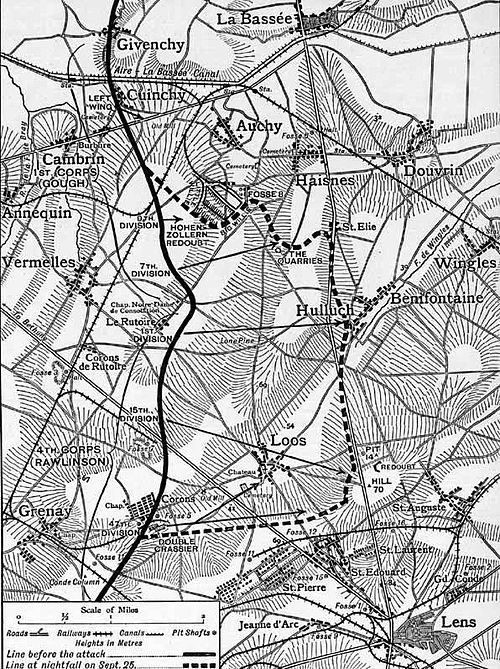
Figure 2. Map of the
Battle of Loos, 25 September 1915.
(Image
courtesy of Wikipedia)
NOTE: The map above shows the line of advance of the 7th Division from east of Vermelles to The Quarries. Presumably Lieutenant Batho was wounded near the trenches close to Vermelles as described below by his company commander.
Major G.F.B. Goldney. D.S.O., Commanding 54th Field Coy., RE., 7th Division, had this to say of John Batho:[21]
" The loss of your son has been a great blow to us all in the company. He was very popular both with officers and men, and his section were devoted to him. I hope it may be a consolation to you to know that he has left a reputation behind him for thoroughly sound work and devotion to duty with all in the Division who knew him. I always knew that any work he was given would be done thoroughly and conscientiously. He was wounded near Vermelles while he and his section were entrenching a point close to a locality held by the Germans. He had been doing a great deal of work during the last month, and it had been wonderfully well done. The company had been engaged on a large system of advanced trench work in preparation for the attack, and he had been superintending very large working parties every night on a great extent of ground. I was very fortunate in having a subaltern who was equal to such work, as it required energy and power of organization of a high order. If he had lived he would undoubtedly have been given a reward, as the CRE and Divisional Staff knew what excellent work he had done. He was always absolutely cool and collected under fire, and the training he had inculcated into his section was very apparent after he was wounded, they carried on with the work under a fairly constant fire, and completed it successfully."
But probably the most stirring words came from John Batho’s Section Sergeant, Sergeant D. McQuiston, who wrote to John’s parents telling them:[22]
"On behalf of No. 2 Section of the 54th Field Coy., RE., it is with the deepest sorrow that I write these lines to let you know, as near as possible, all that happened on the night your son, our commander, received his fatal wound. No words of mine, I am afraid, can help you in this time of grief; but it may be a little consolation to you to know that your son was wounded within a few yards of the enemy's front trench and in front of his own section; also, that he upheld the honour of an officer and true British leader. Life is very short for all of us, and no one can say when his hour may come; but if we are all prepared, as I feel sure your son was, it will not be long before we meet in a happier world than this. It was on the night of the 26th — I believe that is the correct date, though sometimes we forget — the night following the capture of the village of Loos, your son gave me orders to prepare material and tools to construct a hasty redoubt close to the enemy's front trench (about 100 yards). We paraded at 6 p.m., and marched to our original front line; there we entered a communication trench, which would be about two kilometres in length. On arrival at our destination, my orders were to have the section well under cover, whilst your son, Corpl. Radford and myself went to select a site on our right flank for the redoubt. All seemed to be quiet enough, with the exception of a few bullets flying over us at intervals. It was a beautiful moonlight night, and with the addition of the star flares it made the night look like day, which was favourable for any of the enemy's snipers, who, I think, lay hidden in the grass. We took every precaution, as we know they crawl about at night, being too frightened to meet us in the open daylight. We had not been more than 10 minutes there, when suddenly we heard our brave young hero call out to us. We ran to his side and found he was wounded in the back — he had been standing sideways to the enemy's lines the bullet entering one side and passing out the other.[23] We tore his jacket off as quickly as possible, and rendered first-aid in the matter of a few minutes. All the while we were doing this his chief worry was that I should carry through the task allotted to him. for that night, which I afterwards did to the satisfaction of my Commanding Officer. He gave me every little detail with what little strength he had left. When he knew I thoroughly understood, his words to me were — I shall never forget them.: 'Have me taken away from here as quickly as possible ; I am very sorry to leave the section, as they have always worked very hard for me and done their duty to me as men.' Meanwhile I had sent for the stretcher, and it had arrived by the time we had dressed him. I detailed two sappers, Bromilow and Woodford, and two infantry to carry him to the nearest ambulance. When he was being carried away, he cried to us: Good-bye, my men, and good luck to you all! These were the last words I heard from him. I made inquiries if he said much on his way down to the ambulance. Apparently he never said a word till he got into the ambulance and our stretcher-bearers were about to leave him. His thoughts then again turned to his section, and he cried to them ‘Give my kind regards to the section.' It is surprising the effect his loss had upon the section. We all loved him and would follow him anywhere, full of confidence when he was leading us. We shall never find one better, but we are living in hopes of getting one half as good. We hoped when he was wounded that his life would be spared."
His section fixed a beautiful cross on his grave and put railings round it in recognition of their devotion to their esteemed Section Commander.
The probate of John Batho’s Will took place in London on 9 December 1915. His effects, amounting to £263 and 2 pence (about $32,000 US in 2023 currency), were left to his father, Richard William Batho, gentleman who was residing at the family home at 15 Luxemburg Gardens, Brook Green, Middlesex.[24]
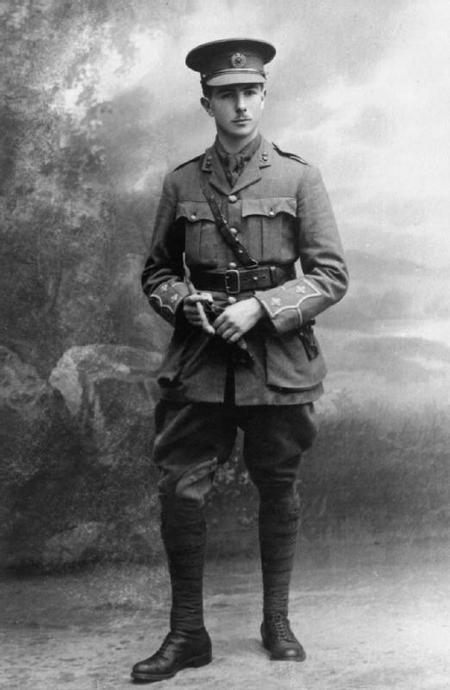
Figure 3. Lieutenant John Batho, R.E.
(Image
courtesy of the Imperial War Museum)
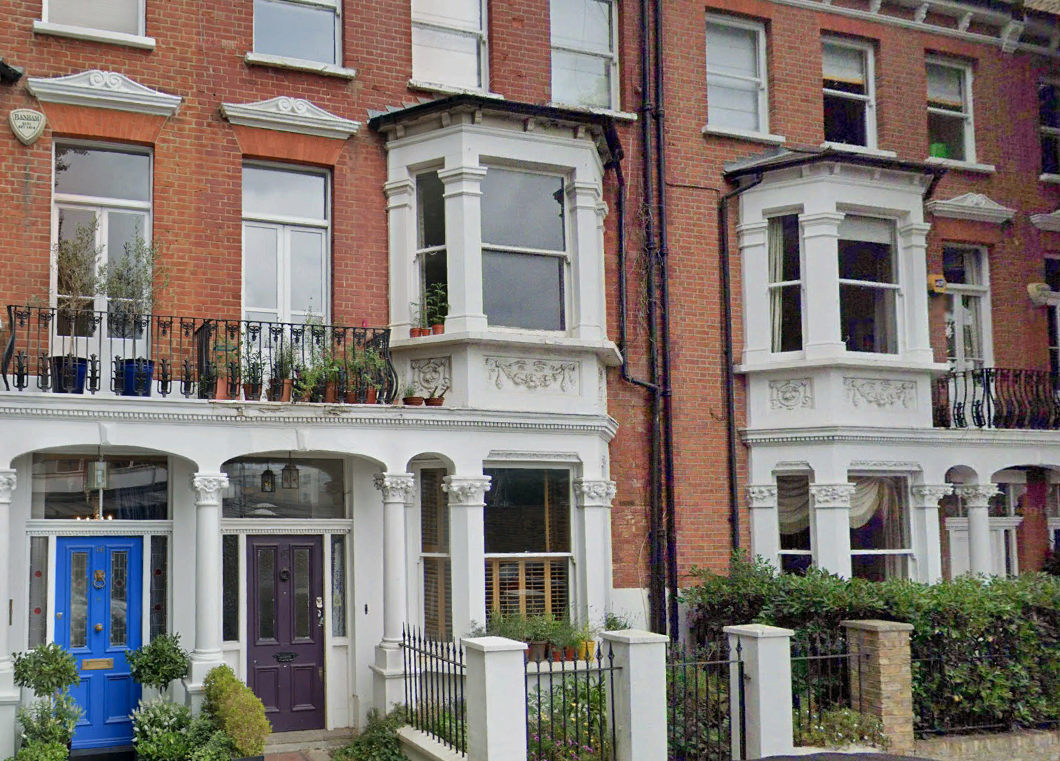
Figure 4. The Batho Family Home at 15 Luxemburg
Gardens,
Brook Green, Middlesex.
(Image courtesy of
Google Earth)
5. MEDALS, AWARDS AND DECORATIONS
For his service during the Great War John Batho’s was awarded the British War Medal and Victory Medal with Mention in Despatches Oak Leaf.[25] Although the M.I.D. was published after his death, his Medal Index Card does indicate that the Oak Leaf emblem was issued.
His Medal Index Card does not indicate who was the recipient of these medals. The medals appear to have been forwarded to his next-of-kin on 13 October 1920. As his father was named in his will, it would seem logical to assume that he received the medals.
His father also would have received a bronze memorial plaque to commemorate John’s death. John Batho’s name would have been cast in the rectangle just above the lion’s head, as shown in Figure 6 below.
|
NOTE: In Figure 7 below, Batho’s rank is given as 2nd Lieutenant; however, he was a Lieutenant when he died of his wounds. |
NOTE: The medals and the plaque shown above are not those awarded to Lieutenant John Batho. They are included here for illustrative purposes only.
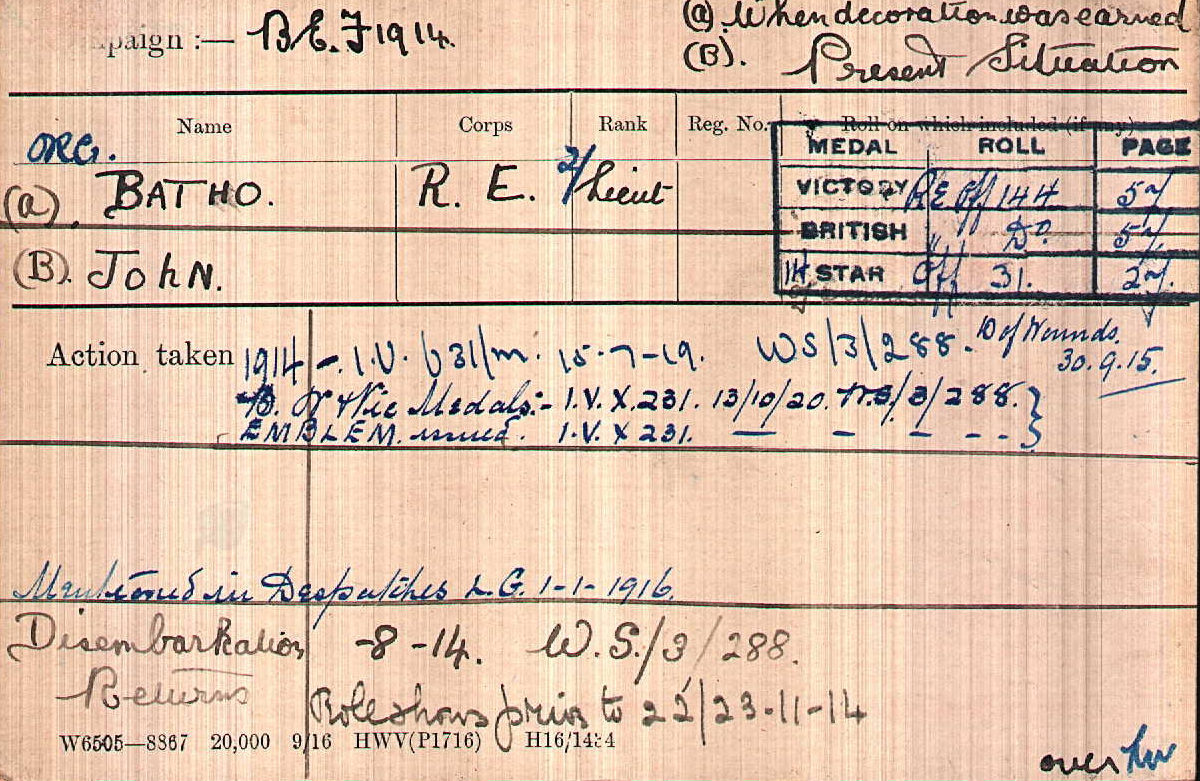
Figure 7. The Medal Index Card of Lieutenant John
Batho.
(Image courtesy of Ancestry.com)
REFERENCES:
Books
DeRuvigny’s Roll of Honour, 1914-1918, Volume 2, Standard Art Book Company, London, p. 21.
DOYLE, Sir A.C. British Campaigns in France and Flanders, 1916. Hodder & Stoughton, London, 1915, p. 195.
DOYLE, Sir A.C. British Campaigns in France and Flanders, 1917. Hodder & Stoughton, London, 1916, p. 149.
Civil Documents
Probate Calendar, 1915, p. 145.
Family Trees
The John Batho Family Tree (by Paula Bailey)
Internet Web Sites
The Long, Long Trail: 7th Division. https://www.longlongtrail.co.uk/army/order-of-battle-of-divisions/7th-division/
Wikipedia: Battle of Neuve Chappelle. https://en.wikipedia.org/wiki/Battle_of_Neuve_Chapelle
Wikipedia: Second Battle of Ypres. https://en.wikipedia.org/wiki/Second_Battle_of_Ypres
Wikipedia: Battle of Festubert. https://en.wikipedia.org/w/index.php?title=Special:DownloadAsPdf&page=Battle_of_Festubert&action=show-download-screen
Military Documents
Medal Index Card
Periodicals
Battle Honours of the Royal Engineers. The Royal Engineers Journal, The Institution of Royal Engineers, Chatham, Kent, 1925-1932.
ENDNOTES:
[1] Batho family trees.
[2] DeRuvigny’s Roll of Honour.
[3] Ibid.
[4] Ibid.
[5] Ibid.
[6] The Long, Long Trail.
[7] Wikipedia.
[8] Commonwealth War Graves Commission.
[9] Wikipedia.
[10] Ibid.
[11] Commonwealth War Graves Commission.
[12] Wikipedia.
[13] Commonwealth War Graves Commission.
[14] London Gazette, 26 June 1915, p. 6241.
[15] The Long, Long Trail.
[16] Wikipedia.
[17] DeRuvigny’s Roll of Honour.
[18] The 54th Field Company suffered a total of 66 fatal casualties during the war.
[19] London Gazette, 1 January 1916, p. 1.
[20] DeRuvigny’s Roll of Honour.
[21] Ibid.
[22] Ibid.
[23] Batho was the victim of an enemy sniper. Artillery fire and snipers appear to be the two main causes of casualties among R.E. officers and men.
[24] 1915 Probate Calendar, p. 145.
[25] Medal Index Card.